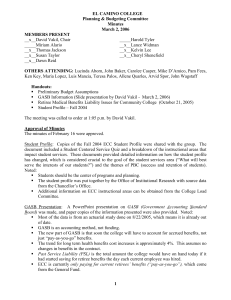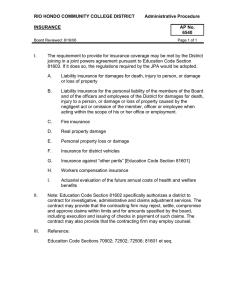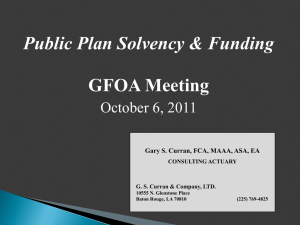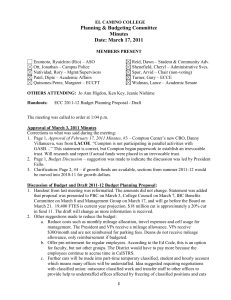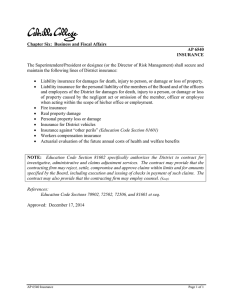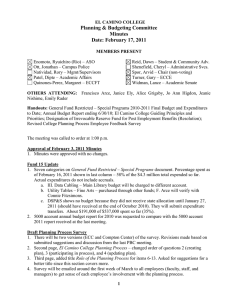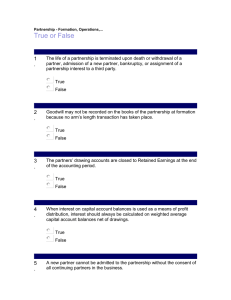June 3, 2010
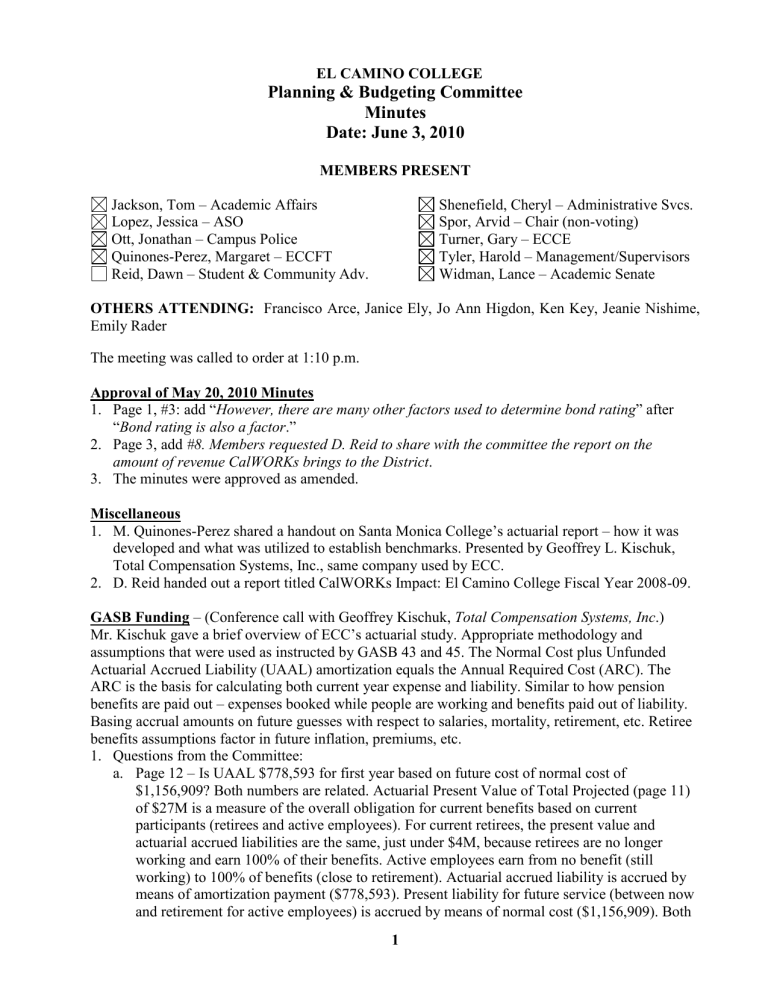
EL CAMINO COLLEGE
Planning & Budgeting Committee
Minutes
Date: June 3, 2010
MEMBERS PRESENT
Jackson, Tom – Academic Affairs
Lopez, Jessica – ASO
Ott, Jonathan – Campus Police
Quinones-Perez, Margaret – ECCFT
Reid, Dawn – Student & Community Adv.
Shenefield, Cheryl – Administrative Svcs.
Spor, Arvid – Chair (non-voting)
Turner, Gary – ECCE
Tyler, Harold – Management/Supervisors
Widman, Lance – Academic Senate
OTHERS ATTENDING: Francisco Arce, Janice Ely, Jo Ann Higdon, Ken Key, Jeanie Nishime,
Emily Rader
The meeting was called to order at 1:10 p.m.
Approval of May 20, 2010 Minutes
1.
Page 1, #3: add “
However, there are many other factors used to determine bond rating
” after
“ Bond rating is also a factor .”
2.
Page 3, add #8. Members requested D. Reid to share with the committee the report on the amount of revenue CalWORKs brings to the District .
3.
The minutes were approved as amended.
Miscellaneous
1.
M. Quinones-Perez shared a handout on Santa Monica College’s actuarial report – how it was developed and what was utilized to establish benchmarks. Presented by Geoffrey L. Kischuk,
Total Compensation Systems, Inc., same company used by ECC.
2.
D. Reid handed out a report titled CalWORKs Impact: El Camino College Fiscal Year 2008-09.
GASB Funding – (Conference call with Geoffrey Kischuk, Total Compensation Systems, Inc .)
Mr. Kischuk gave a brief overview of ECC’s actuarial study. Appropriate methodology and assumptions that were used as instructed by GASB 43 and 45. The Normal Cost plus Unfunded
Actuarial Accrued Liability (UAAL) amortization equals the Annual Required Cost (ARC). The
ARC is the basis for calculating both current year expense and liability. Similar to how pension benefits are paid out – expenses booked while people are working and benefits paid out of liability.
Basing accrual amounts on future guesses with respect to salaries, mortality, retirement, etc. Retiree benefits assumptions factor in future inflation, premiums, etc.
1.
Questions from the Committee: a.
Page 12 – Is UAAL $778,593 for first year based on future cost of normal cost of
$1,156,909? Both numbers are related. Actuarial Present Value of Total Projected (page 11) of $27M is a measure of the overall obligation for current benefits based on current participants (retirees and active employees). For current retirees, the present value and actuarial accrued liabilities are the same, just under $4M, because retirees are no longer working and earn 100% of their benefits. Active employees earn from no benefit (still working) to 100% of benefits (close to retirement). Actuarial accrued liability is accrued by means of amortization payment ($778,593). Present liability for future service (between now and retirement for active employees) is accrued by means of normal cost ($1,156,909). Both
1
numbers are related – both total present value and combined expected to accrue the entire amount of obligation. b.
What are post-65 benefits the District is required to recognize/accrue in compliance to GASB
43 and 45 (page 11)? Post-65 benefits are statutory minimum benefits under 22819
Government Code and the District is required to contribute under CalPERS health plan.
Current amount is $105 per person, and will go up to $108 next year. Section 22895 requires statutory minimum is adjusted each year to reflect medical component of CPI. Page 22 shows Distribution of Eligible Participants by Age table. Approximately 190 current retirees over the age of 65 are receiving the statutory minimum contribution paid by the District. c.
What is the amount per year for total liability if reflected assets are earmarked to comply with GASB 43 and 45 and if assets were in an irrevocable trust (page 12)? Not possible to give exact figure because it depends on several factors. 1) If money is in irrevocable trust, different trust vehicles are available and each has different policy expected to generate a different rate of return. Interest rate is determined in part by expected return on plan assets and without knowing the adjustment policy of trust, it is not possible to determine interest rate for plan assets. Interest rate has impact on liability. 2) The interest rate depends on how trust is funded. 3) The numbers in this report are already a year old and CalPERS health plan rates have changed. CalPERS and CalSTRS new assumption tables can also have impact on these numbers. Would a projected 1% rate of return lower the liability if put into an irrevocable trust as opposed to a non-irrevocable trust? Certain accounting elements of a trust are done outside the valuation report. Need to look at valuation impact and accounting impact as well. Generally, there is no overall impact of putting money in a trust, if the rate of return is the same. If there are plan assets in an irrevocable trust, it would reduce liability within the valuation. d.
If we were in different economic times, and there was a spread between short-term and longterm interest rates and if the College committed a large amount in an irrevocable trust, wouldn’t that bring the numbers down? Valuation is affected by how much money moved, terms of trust, expectations for investment return, and the portion expected. Better if money set aside is earning more money than keeping it where it is. e.
Trend predictions and recommendation is a key factor in how a college establishes criteria to use according to presentation made at Santa Monica College. Trend recommendation used on
ECC Actuarial Report was 4%. What would this report look like if other recommended trends were used? There is big distinction between situations at ECC and SMC. By contrast,
SMC basic contribution is tied to the Kaiser rate. ECC post-65 liability is over half of the liability (page 12). Appropriate for ECC to use lower trend than SMC. If one of other three predictors were used, liability would increase. Is meeting almost 50% of the liability a good position to be in? Hard to determine; each case is different. Based upon liability met, would this severely damage audit/bond rating? Generally, ramifications depend on how information is used and who uses it (i.e. government, accreditation, bond rating agencies). f.
Any sense how many community colleges have an irrevocable trust? Probably more than
25% but less than 50%. g.
What affect would a previous valuation have if one had been done (page 18)? Meant to say in the report that a previous valuation had not been done for GASB purposes; this is the first report that would be used in compliance with GASB 43 and 45. h.
Didn’t the report state there will be more retirees than in the past? Figures given did not look significantly different and thought ECC always had a higher percentage of older employees.
Don’t recall making that statement in the report, but expect more viable option for employees would be to continue working after age 65. CalPERS/CalSTRS retirement schedules are typically used.
2
2.
Is the percentage of employees carrying premium insurance high? Not for newer employee, but it appears about two-thirds have PERS CARE, PERS CHOICE over Kaiser or Blue Shield HMO.
Retirees tend to keep more expensive plan until age 65 when they receive Medicare. Not longterm liability to College, depending on when employee retires.
3.
Why does ECC have to pay $105 for post-65 employees? This payment is made to CalPERS for every retiree. Also reimbursing retirees for health care premiums taken from paychecks. If retirees are over 65, what health benefits are they receiving? Statutorily must pay $105 as part of the overall health care system. Will follow-up with Lynn Solomita with this question.
4.
J. Higdon read statement from President Fallo: President Fallo appreciates the time and effort this committee spent on this matter. He thanks the committee for their input and recommendations. Historically, most of the committee’s recommendations have been accepted by the President. Given the serious commitment made by the District to provide employee retiree health benefits, it would be fiscally irresponsible not to appropriately fund this District’s financial liability. The actuarial report specifies an annual commitment of just under $1.4M that is needed to fund our plan annually. The President will be recommending to the Board an increase in funding from the previous amount of $900,000 to $1.4M. a.
Committee member asked if the Board will receive PBC’s recommendation or just the
President’s recommendation. In this past he indicated differences between his recommendation and PBC’s. The Committee should ask the President. b.
$900,000 was budgeted from Fund 15 on the 2010-11 tentative budget. Where will the additional $500,000 come from? Taken from another program? Not known at this time. PBC had past discussion on GASB funding coming from Fund 11. Past discussions included unused Fund 15 funds going to the GASB fund, but over time still should be the District’s responsibility. What’s the timeframe to gradually switch funding from Fund 15 to Fund 11?
Received committee consensus when discussed in the past to follow a four-year time frame.
5.
Committee member made a motion to recommend that the District not fund GASB in 2010-11.
No one seconded motion – motion failed.
6.
A recommendation was made to leave 2010-11 funding at $900,000 pending more information on funding source for the additional $500,000 based on the President’s recommendation. When will Fund 11 take over funding for GASB? Vote to recommend: 6 yes; 1 no; 2 abstained.
7.
Should unspent Fund 15 be used for categorical programs? PBC already recommended that unspent funds from Fund 15 should be used for GASB. Statement was made that the College should consider using unspent funds to help categorical programs. The State, not the College, cut funding from categorical programs.
Prioritized Area Planning Process
1.
SCA Overview – Managers worked with their programs to prioritize top salary positions requested (vacant or new), one-time and on-going funding requests. In area meeting, each manager brought forward their top three requests providing written rationale. Verbal discussion took place. Managers voted anonymously through a survey. Top positions voted by SCA managers: Assessment Center Clerical (replacement for retiree), Evaluations Specialist (new),
VP-SCA Secretary (new), Research Analyst (new), Matriculation Advisor (open), Student
Development Secretary (new), Sports Information Coordinator (new), Appointment Center
Clerical (new), Data Entry Operator-Appt Center (new), and Certified Athletic Trainer (new).
2.
Categorical programs were asked to submit augmentation request for available money ($1M).
Categorical managers came back with counter-proposal of $1.5M. VPs thought that taking half of $3M was not reasonable. CalWORKs asked for funding for child care and work study.
Questions raised to whether district funds could be used for child care and work study. Waiting for legal opinion from Steve Bruckman to verify if appropriate expenses for district funds.
Program managers met again and revised request which is now being reviewed by the VPs.
3
3.
The College is committed to provide as many services to students as possible to accomplish their goals. Should every program get a little funding or is it best to fully fund programs with the greatest impact?
4.
To take $500,000 more for GASB will be at the expense of some program(s). Have discussions already taken place? No conversations have taken place regarding reducing allocations already made to categorical programs/projects in the 2010-11 tentative budget. The President knows that
PBC already recommended using any remaining balance from Fund 15 for GASB.
5.
What will happen to CalWORKs students if the State cut their support - will they continue their education? Education would become secondary priority for low income students just trying to figure out how to live.
The next meeting is scheduled on June 17, 2010 and will be chaired by Harold Tyler.
The meeting ended at 2:35 p.m.
4
